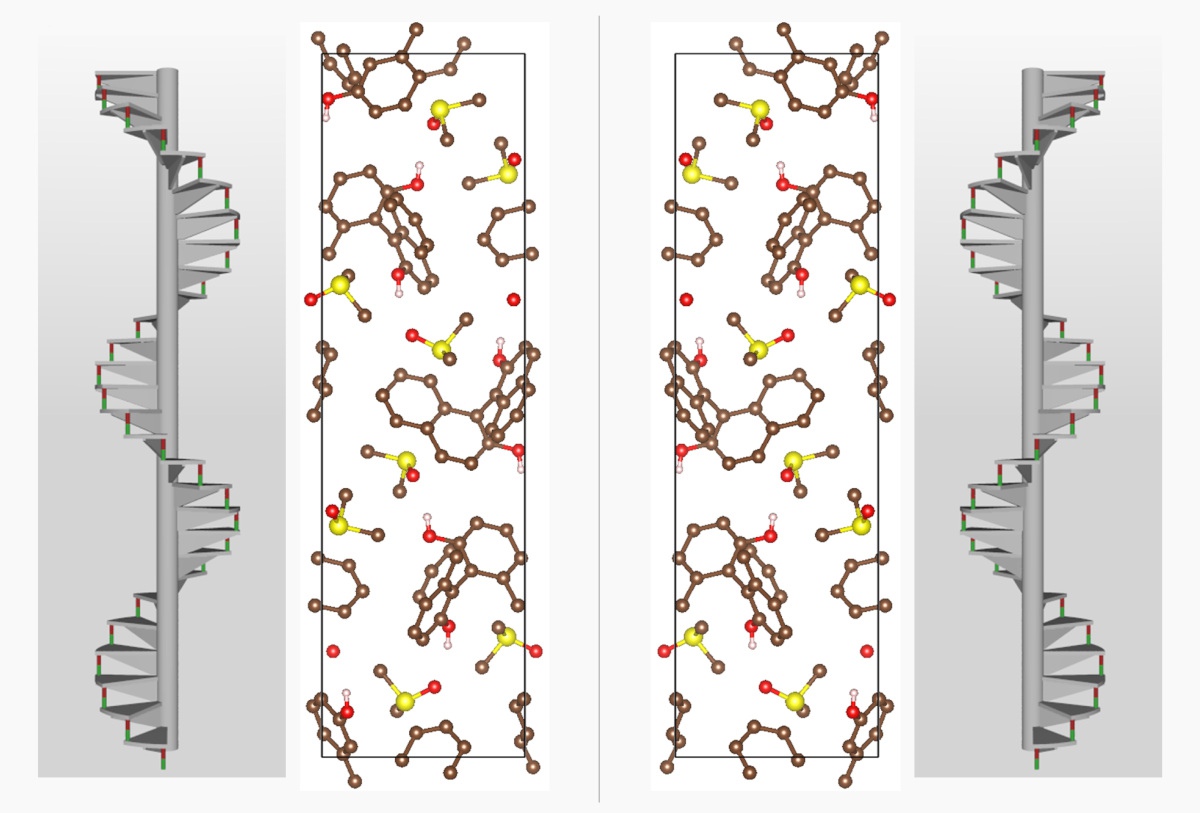New Chiral Molecular Ferroelectrics
© The Physical Society of Japan
This article is on
Ferroelectric Transition of a Chiral Molecular Crystal BINOL∙2DMSO
(JPSJ Editors' Choice)
J. Phys. Soc. Jpn. 91, 064702 (2022).
A new chiral ferroelectric material is discovered in a purely organic system, 1,1’-bi-2-naphthol・2 dimethyl sulfoxide (BINOL・2DMSO).

Left- and right-handed crystalline structures of BINOL∙2DMSO. Inside the chiral framework of BINOL, polar molecules DMSO produce the electric polarization.
Ferroelectrics are widely used for applications including capacitors, memory, and speakers. Despite the extensive research in this field, it remains challenging to theoretically predict new ferroelectric material groups, and in most cases, the discovery of new ferroelectric families is coincidental.
In this research, the authors report a new molecular ferroelectric material with a chiral crystal structure, 1,1’-bi-2-naphthol・2 dimethyl sulfoxide (BINOL・2DMSO). In this crystal, chiral molecules (BINOL) form the structural framework, and DMSO molecules are present at the gap as a guest. At room temperature, the orientation of the DMSO molecule is fluctuating. However, when the crystal is cooled down, the fluctuation is suppressed and the ordering of DMSO occurs at 190 K. At this point, the electric dipole moment of DMSO also orders, resulting in a ferroelectric transition along with the crystal-symmetry breaking. At 125 K, another structural transition occurs. The space group of the crystal subsequently changes as P41212 → P41 → P1121. Because of the chiral framework of BINOL, all of these crystal structures are also chiral.
This results of this study demonstrate that when chiral molecules such as BINOL incorporate polar molecules and form a composite molecular crystal, they generally become a chiral (anti-)ferroelectric crystal. This will be useful to guide future research into new chiral ferroelectric materials.
(Witten by T. Nomura on behalf of all authors)
Ferroelectric Transition of a Chiral Molecular Crystal BINOL∙2DMSO
(JPSJ Editors' Choice)
J. Phys. Soc. Jpn. 91, 064702 (2022).
Share this topic
Fields
Related Articles
-
d2 Trimer and d3 Tetramer in a Pyrochlore Lattice
Dielectric, optical, and other properties in condensed matter
Electron states in condensed matter
2024-7-11
Based on the charge disproportionation of V3+ and V2+, the V3+(d2) trimers and V2+(d3) tetramers in the vanadium pyrochlore lattice of AlV2O4 are described by the orbitally-induced Peierls mechanism.
-
Structural Rotation and Falsely Chiral Antiferromagnetism: A New Combination Generating Ferrotoroidic State
Magnetic properties in condensed matter
Dielectric, optical, and other properties in condensed matter
2024-7-4
The ferrotoroidic state, an exotic state of matter with broken space inversion and time-reversal symmetries, was achieved by combining structural rotation and falsely chiral antiferromagnetism in PbMn2Ni6Te3O18.
-
Current Melt Frozen Electrons
Dielectric, optical, and other properties in condensed matter
Magnetic properties in condensed matter
2024-1-15
The origin of the current-induced insulator-to-metal transition of samarium monosulfide was explained by the 4f−5d hybridization observed using optical reflectivity and photoelectron spectroscopies.
-
One-Way Optical Waveguide Realized by Edge Modes of Topological Photonic Crystals
Electromagnetism, optics, acoustics, heat transfer, and classical and fluid mechanics
Dielectric, optical, and other properties in condensed matter
2023-12-12
A one-way optical waveguide was realized on the boundary between two types of photonic crystals with different topological properties, which were demonstrated by high-resolution infrared reflection measurements.
-
Dzyaloshinskii–Moriya Interactions in Magnetism, Electricity, and Electronics
Magnetic properties in condensed matter
Electron states in condensed matter
Dielectric, optical, and other properties in condensed matter
2023-10-12
A collection of papers in the Journal of the Physical Society of Japan advances our understanding of Dzyaloshinskii–Moriya interaction and paves the way for developing next generation computing and electronic systems.
